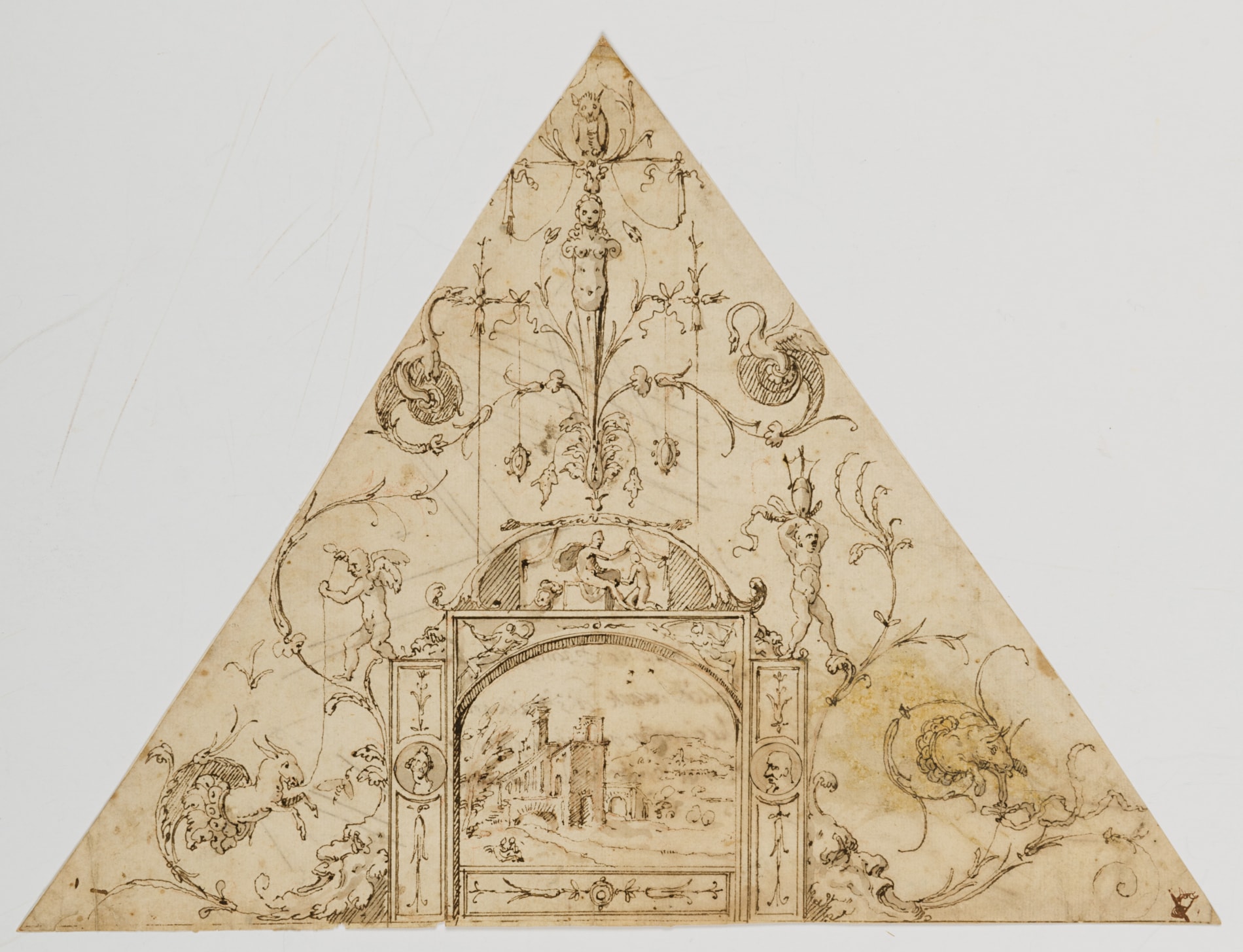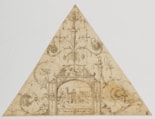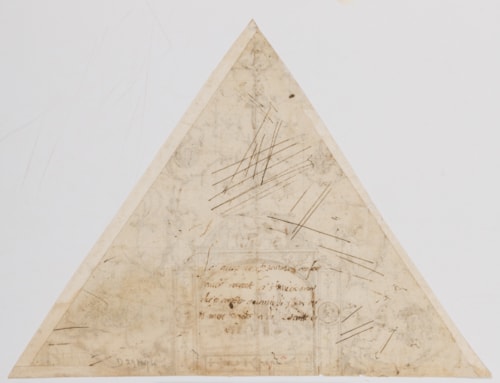LUZIO ROMANO
( c.1528 - c.1575)
A Design for the Grotesque Decoration of a Quarter Section of a Ceiling, with a Landscape with a Ruin
Pen and brown ink and brown wash. laid down on an old mount.
Inscribed Io aucuno [...] confece / anc. recente a [...] ama / che si confiar […] di [...] / il mese […] o di […] on the verso.
Inscribed with a Colnaghi stock number D29494 / style of Giov. da Udine on the old mount.
211 x 288 mm. (8 3/8 x 11 3/8 in.)
Inscribed Io aucuno [...] confece / anc. recente a [...] ama / che si confiar […] di [...] / il mese […] o di […] on the verso.
Inscribed with a Colnaghi stock number D29494 / style of Giov. da Udine on the old mount.
211 x 288 mm. (8 3/8 x 11 3/8 in.)
Bert Meijer has attributed the present sheet to Luzio Romano, whose drawings are characterized by a somewhat simplistic figure style and delicate penwork. This drawing for the decoration of a ceiling is, as Peter Fuhring has pointed out, very closely related to another drawing of similar dimensions – also triangular in shape, with the same decorative elements, and undoubtedly for the same project – in the Royal Collection at Windsor Castle. The Windsor drawing, as Philip Pouncey and John Gere note, is part of ‘a number of grotesque drawings…[which] form part of a whole collection of late Perinesque architectural and ornamental studies, some of which are connected with the Castel Sant’Angelo, while others cannot be earlier than the 1560’s.’ Like the present sheet, the Windsor drawing was associated by A. E. Popham with Giovanni da Udine (1587-1564), but was later attributed by Anthony Blunt to an artist in the circle of Perino del Vaga. Fuhring has noted that the Windsor drawing has also been attributed to Marco Marchetti, called Marco da Faenza (1520-1588), but on balance an attribution to Luzio Romano seems most probable.
As Fuhring has further noted of the present sheet, as well as the related drawing at Windsor Castle, ‘The existence of two drawings of the same subject poses the problem of their relationship, as well as that of the designer and of their link with the executed work. Was one of the drawings the preparatory design for a frescoed ceiling decoration? Or were both drawings made after a now-lost, or not-yet published, painted ceiling decoration? Was one of the drawings made after the other, or were both made after an untraced original drawing?…The [present] drawing can be dated to the period 1540-50, it was executed in Rome and can be linked with the decoration of the apartment of Pope Paul III in the Castel Sant’Angelo by Perino del Vaga and his workshop.’
Stylistically comparable drawings by Luzio Romano are in the Uffizi in Florence, the British Museum and the Victoria and Albert Museum in London, the Metropolitan Museum of Art in New York, the Biblioteca Comunale in Palermo and the Royal Collection at Windsor Castle, as well as the Biblioteca Academiei Romî in Bucharest.
As Fuhring has further noted of the present sheet, as well as the related drawing at Windsor Castle, ‘The existence of two drawings of the same subject poses the problem of their relationship, as well as that of the designer and of their link with the executed work. Was one of the drawings the preparatory design for a frescoed ceiling decoration? Or were both drawings made after a now-lost, or not-yet published, painted ceiling decoration? Was one of the drawings made after the other, or were both made after an untraced original drawing?…The [present] drawing can be dated to the period 1540-50, it was executed in Rome and can be linked with the decoration of the apartment of Pope Paul III in the Castel Sant’Angelo by Perino del Vaga and his workshop.’
Stylistically comparable drawings by Luzio Romano are in the Uffizi in Florence, the British Museum and the Victoria and Albert Museum in London, the Metropolitan Museum of Art in New York, the Biblioteca Comunale in Palermo and the Royal Collection at Windsor Castle, as well as the Biblioteca Academiei Romî in Bucharest.
Active between c.1528 and 1575, the Roman painter, stuccatore and draughtsman Luzio Luzzi, called Luzio Romano, is only briefly mentioned by Giorgio Vasari as one of Perino del Vaga’s assistants. In fact, he was among the most important artists and stuccatori in the circle of Perino, with whom he worked on the stucco decoration and grotesques in the Palazzo Doria in Genoa in the late 1520s and early 1530s, and again at the Castel Sant’Angelo in Rome around 1545. Known in particular for his expertise in all’antica decoration, Luzio painted a significant number of the frescoes, grottesche and stuccoes in the Castel Sant’Angelo, notably on the walls and ceiling of the Sala della Biblioteca and the so-called Cagliostra rooms. As Philip Pouncey and John Gere have noted, Luzio was ‘a specialist in grotesque and ornament, trained under Perino and apparently operating in the Castel Sant’Angelo with some measure of independence.’ Luzio Romano also worked in a chapel in the Roman church of Santa Maria in Via in 1548, now destroyed, and also possibly at the Villa Giulia between 1553 and 1554. Alongside Daniele da Volterra, Luzio decorated the ceiling of the church of San Giovanni in Laterano from 1563 onwards, and is also known to have worked on the interiors of the Massimo di Pirro, Firenze, Cenci Maccarani and Strada palaces in Rome, as well as the Palazzo Odescalchi in Bassano di Sutri and the Palazzo Crispi in Bolsena. He also received payments for paintings and stucco work in the Vatican in 1565 and at the Palazzo dei Conservatori in 1575, and is thought to have made designs for lavish objects and silverware.
Provenance
Major A. Merz
Bought from him on 13 May 1966 by P. & D. Colnaghi, London, for £40
Sold by them on 25 October 1966 to Lodewijk Houthakker, Amsterdam (Lugt 3893).
Bought from him on 13 May 1966 by P. & D. Colnaghi, London, for £40
Sold by them on 25 October 1966 to Lodewijk Houthakker, Amsterdam (Lugt 3893).
Literature
Roeland D. Kollewijn, ed., Wanden en plafonds: Tekeningen uit de verzameling Lodewijk Houthakker, exhibition catalogue, Nijmegen, 1985, p.15, no.9 (as Italian School, mid 16th century); Peter Fuhring, Design into Art: Drawings for Architecture and Ornament. The Lodewijk Houthakker Collection, London, 1989, Vol.I, p.165, no.130 (as Circle of Perino del Vaga, and dated c.1540-1550).
Exhibition
Nijmegen, Museum ‘Commanderie van Sint Jan’ and Haarlem, Frans Halsmuseum, Wanden en plafonds: Tekeningen uit de verzameling Lodewijk Houthakker, 1985, no.9 (as Italian School, mid 16th century).





